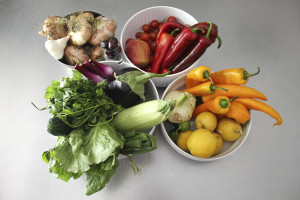
When you want to feed your family healthy food, get back to the basics with whole foods. A whole foods diet is based on choosing items that are unprocessed or minimally processed.
How can you tell if something is a whole food? In “The Omnivore’s Dilemma,” author Michael Pollan offers some candid advice to help you figure it out easily: “Don’t eat anything your great-great grandmother wouldn’t recognize as food.”
This means skipping the Pop-Tarts at breakfast and instead eating some oatmeal topped with fresh fruit. It means avoiding the fast food line at lunch and opting for a turkey sandwich on whole wheat with a side of fresh veggies. It means passing on those little plastic, frozen entrees at dinner and enjoying baked salmon with roasted root vegetables and wild rice.
Naked Apple Pie
With fall upon us, try this quick and satisfying apple dessert that tastes like apple pie:
- 2 apples, cut into slices
- ¼ cup water
- 1 tbsp lemon juice
- Cinnamon to taste
Mix the water and lemon juice together in a bowl. Place the apples in the bowl and mix around to have the slices covered by the water/lemon mixture. Place apple slices on a baking sheet and bake at 350 degrees until tender but not mushy, about 10 to 15 minutes. Cool, sprinkle with cinnamon, and enjoy a delicious whole foods dessert.
If this all sounds overwhelming, you can make gradual changes. Start by adding more fruits and vegetables to your family’s diet. Ideally, each meal and snack will include a fruit, a vegetable or both.
Here are some ideas to get you started:
Breakfast: An omelet with chopped veggies; whole wheat toast with peanut butter and banana; vanilla yogurt with mixed fruit.
Lunch: Grilled chicken wrapped with lettuce, tomato, and feta cheese in a whole wheat tortilla; Mexican quinoa salad with corn, peppers and black beans; tuna salad on a bed of lettuce and carrots.
Dinner: Homemade veggie pizza on whole wheat crust; beef and vegetable stew (aim for 2/3 veggies, 1/3 beef); chicken and veggie stir-fry over brown rice.
Snacks: Green smoothies (milk, fruit, leafy greens); hummus and raw veggies; “bugs on a log” (celery with nut butter and raisins); baked potato topped with salsa.
Another tried-and-true way to incorporate more fruits and vegetables into your meal plans: Take a trip to your local farmer’s market.
By choosing foods that are in season, you’ll be sure to get the best flavor and nutrition. It’s also a great way to try some less familiar items.
Not sure what kohlrabi is or how to use persimmons? Ask your farmer—they often have great ideas about how to use the produce you pick.
 /a>
/a>
 /a>
/a>
 /a>
/a>